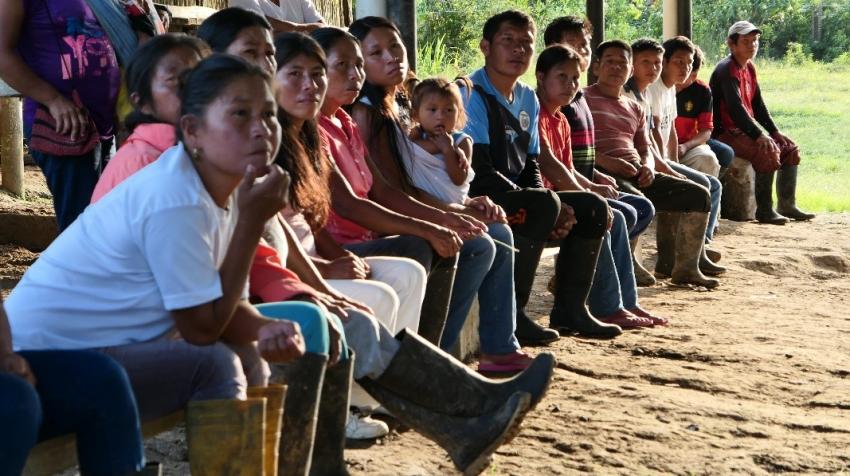Ensure access to water and sanitation for all is a specific call for action as per the Sustainable Development Goal 6. Moreover, according to a General Comment issued by the UN Committee on Economic, Social and Cultural Rights, access to safe and potable water and adequate sanitation, is a critical component of the human right to health. Yet, as shown by the State of the World’s Indigenous Peoples published by the United Nations, “Indigenous peoples’ health status is severely affected by their living conditions,” including minimal access to safe water and sanitation.
Huamaurco, a term that means bamboo mountain in the Kichwa language, is a hilltop community of around three dozen Indigenous families in the Ecuadorian Amazon, just 4 km away from Tena, the 30,000-person capital city of the Napo province. Despite such proximity, Huamaurco, represents a peculiar pocket of deprivations close to a major city with well-developed infrastructure. No one in there has a regular remunerated job. While men occasionally work as day laborers to generate some income, women are engaged in care tasks and tend their crops.
There are no cars or motorcycles. Henry Grefa, one of the young residents of Huamaurco, says that “the road reached the community in 2013, and the electricity in 2015.” Still, other basic services such as clean water, are insufficient or non-existent. In such dire conditions, Ikiam Amazon Regional University, a UNAI member institution in Ecuador, partnered last year with the community of Huamaurco, the Polytechnic University of Catalonia in Spain, and two civil society organizations -ENGIM and Green Empowerment-, to develop a comprehensive water project.
The idea of such project, which is carried out with funding provided by the Christadelphian Meal-a-Day Fund of the Americas, is to supply potable water and treat the resulting wastewater in this vulnerable and rural community. Up until early this year, members of the community gathered water from small cave-fed springs or rainwater in jerry-cans. Women in the community carried laundry to nearby streams and, in the company of their children, washed their clothes. No family had even rudimentary means for sanitation, and open defecation was the norm.
Close to the center of this string of houses in Huamaurco there is a natural depression, where two small caverns provide a constant source of water. “When it rains, water comes out almost like a waterfall, but if it does not rain for a few days, the water slows to a trickle,” says Natalia Licuy, one of the new water system’s technician/operators. A few days without rain is quite notable in Huamaurco. Simple weirs allow nearly all of the water from the caverns to be captured during dry periods, while almost all is diverted to a streambed during rain events.
The collected water flows through a roughing filter and slow sand filter, with final treatment provided by a low-cost chlorination system developed by EOS International. Green Empowerment´s partner, Samuel Schlesinger, who designed the water system, explains that “once the water is filtered and chlorinated, it flows to a reservoir which provides gravity distribution to one of the neighborhoods, lower on the ridge. An electric pump moves water from the same tank to a water tower at the highest part of the ridge to supply the other two, higher neighborhoods.”
To complete the system, the community dug over 2 km of trenches and laid pipes, working through mingas, an ancestral system of communal work in which everyone participates. Now, thanks to their own efforts, every family has drinking water delivered to their homes. Along these lines, community management of water systems is critical to sustainability, and as part of the project, a local water committee was created and trained. Such committee has representatives from each of the three neighborhoods. Also, two women were chosen as system technicians.
As for wastewater treatment, the project provides sanitation facilities (toilet, shower, and sink) for all the families to ensure a comprehensive impact. The bathroom cabins are built mainly with local materials such as bamboo or wood, and the project provides additional non-local materials (cement, plumbing, roofing, toilet, sink, showerhead, among others), as well as skilled labor and the design of the bathrooms. “We built the bathrooms ourselves,” explains Remigio Mamallajta. In fact, the initial design was improved based on the contributions of the families.
Since homes in the community are dispersed, decentralized treatment systems for each family made the most sense. The wastewater that comes from each toilet enters two low-cost tubular biodigesters placed in series, which discharge the treated water to a small artificial wetland. Gray water from the shower and sink flows directly into the small wetland. This wastewater treatment design using biodigesters and artificial wetlands was validated at scale by the UNAI member institution which, implemented a similar system that treats 25% of the university’s wastewater.
Jaime Martí, professor at the Ikiam Amazon Regional University and project leader, says that “having a wetland in the final part of the treatment, plants grow and recover the nutrients present in the wastewater. All you need is to cut these plants twice per year, and the nutrients can be returned to the chakra”. The water system was completed in February 2021, and sanitation implementation is being completed. This shows how universities work jointly with communities to address their needs and apply innovative solutions, with their active involvement.

